
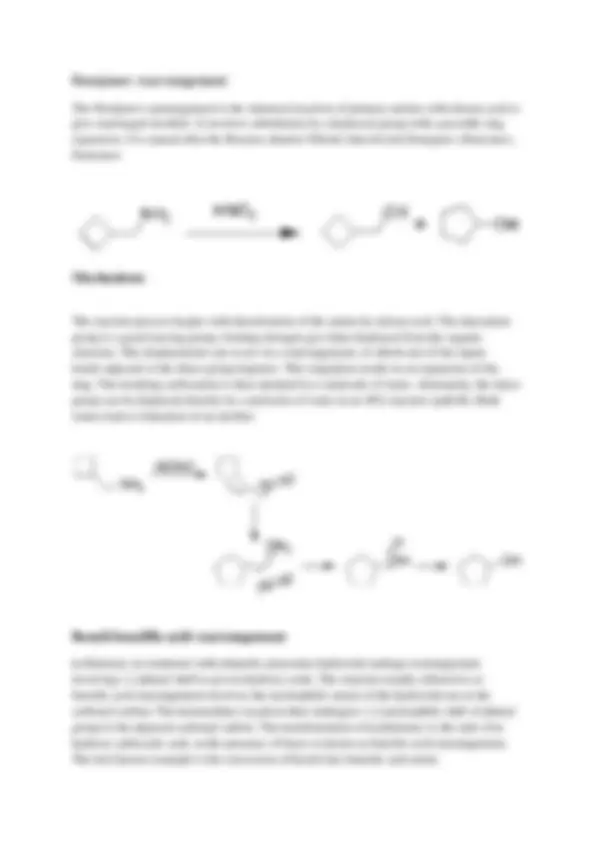
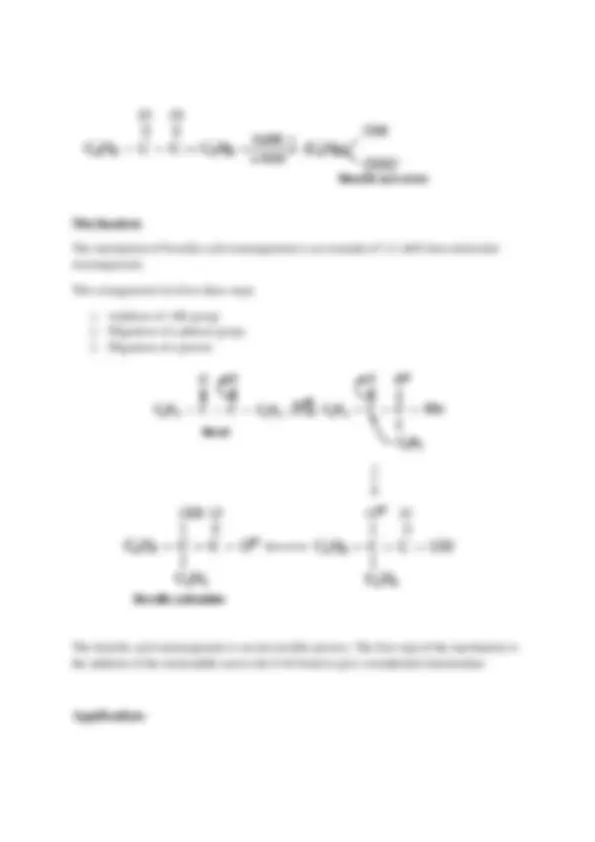
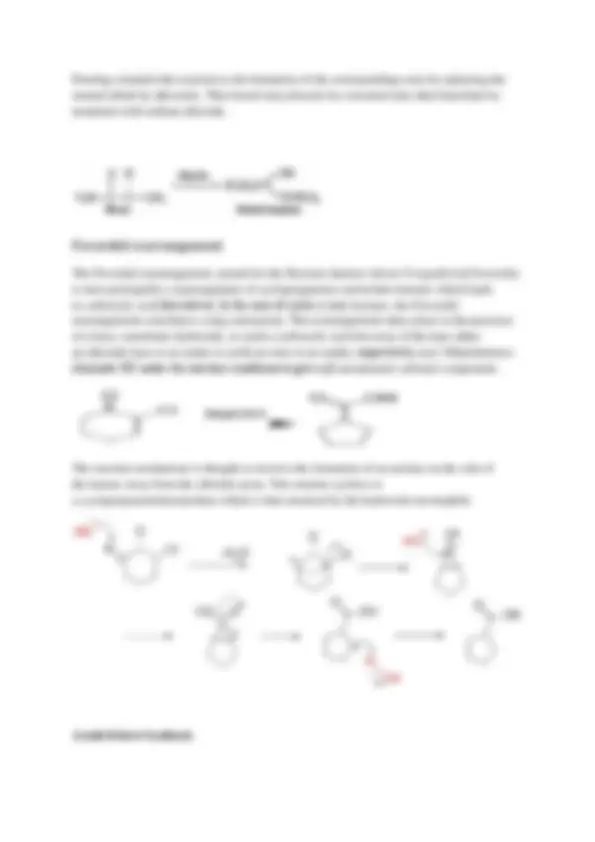
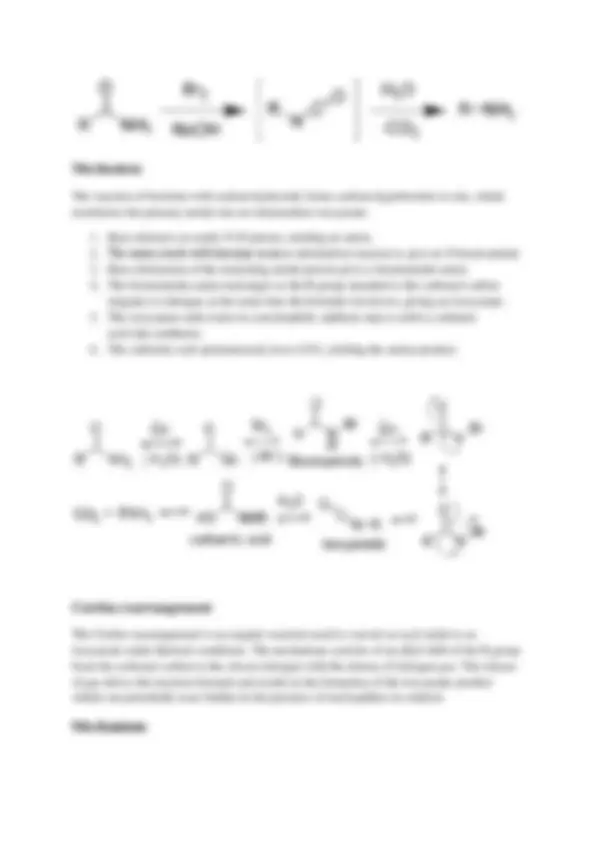
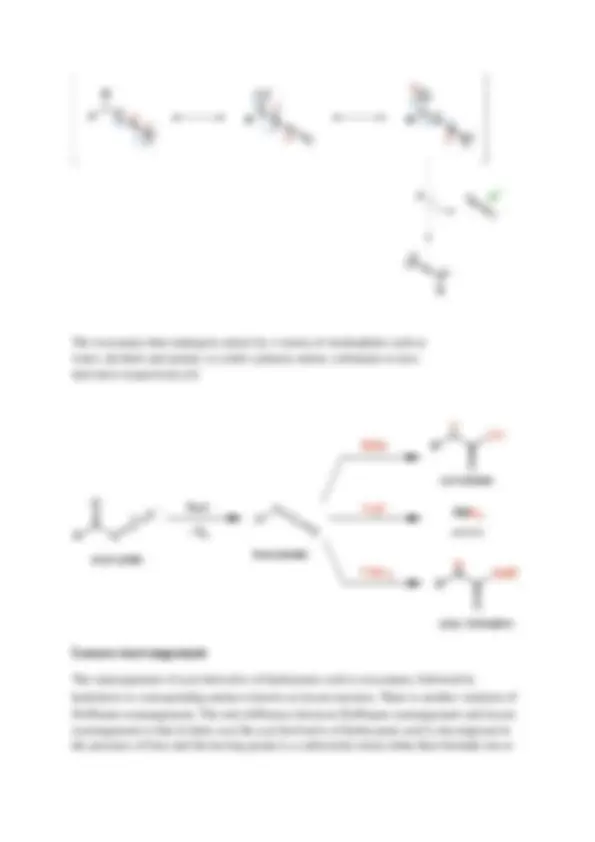
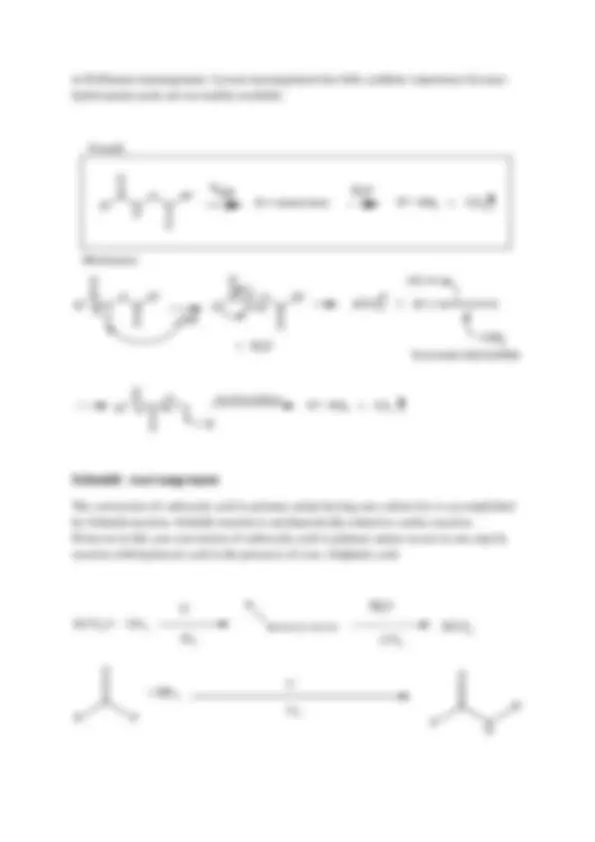
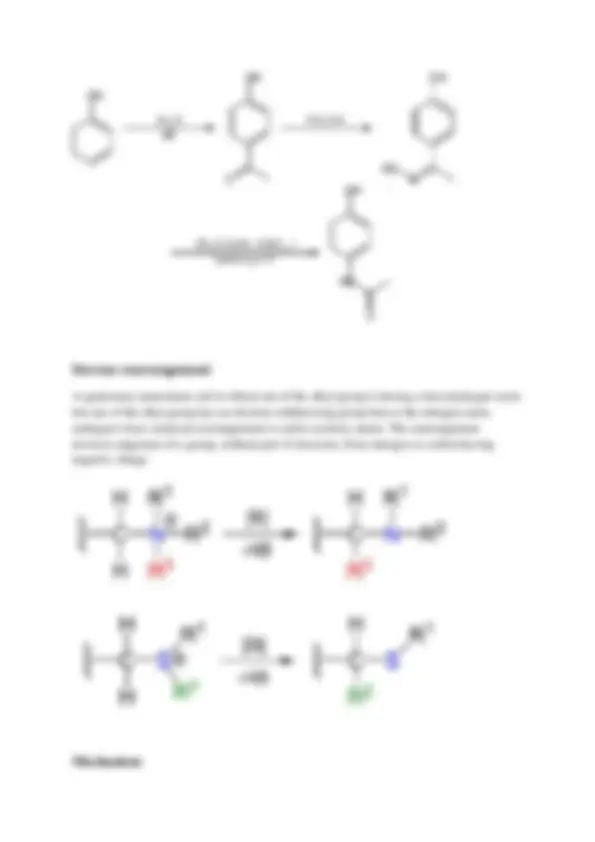
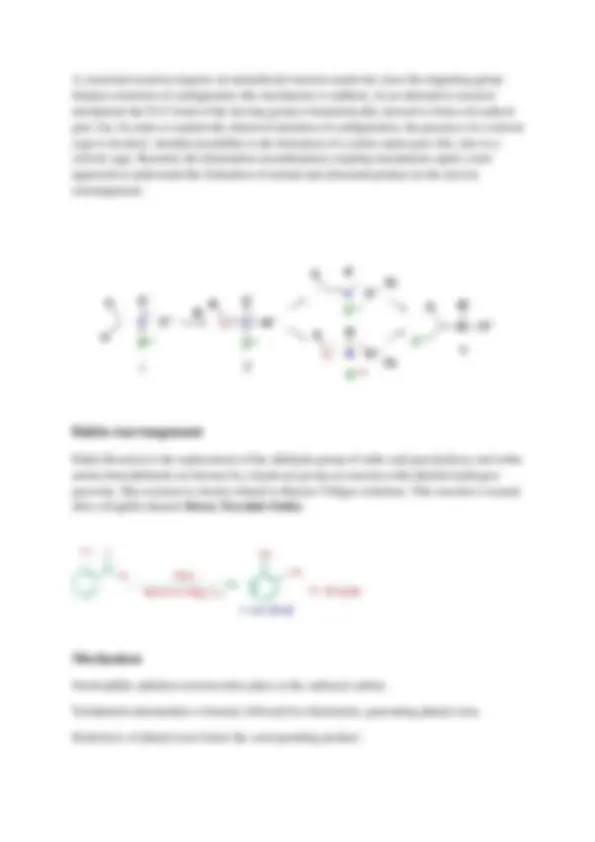
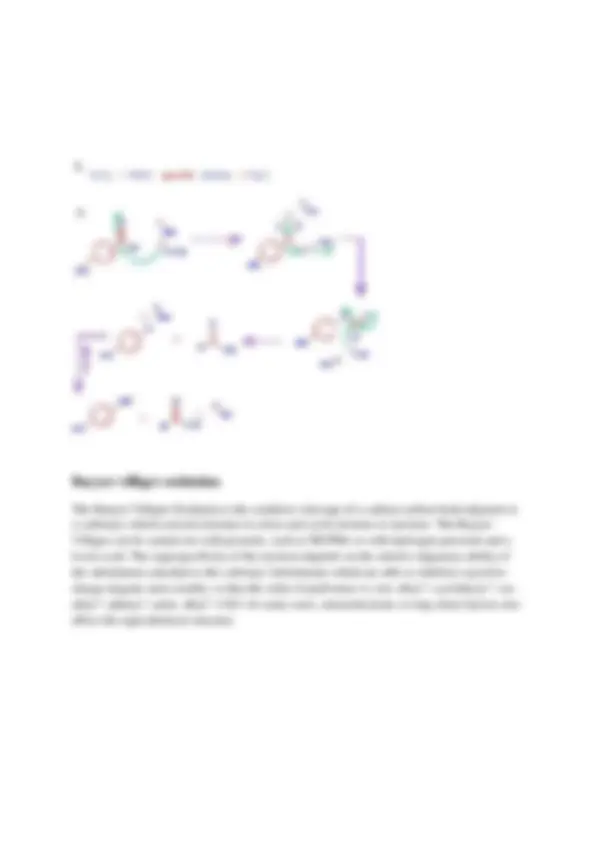
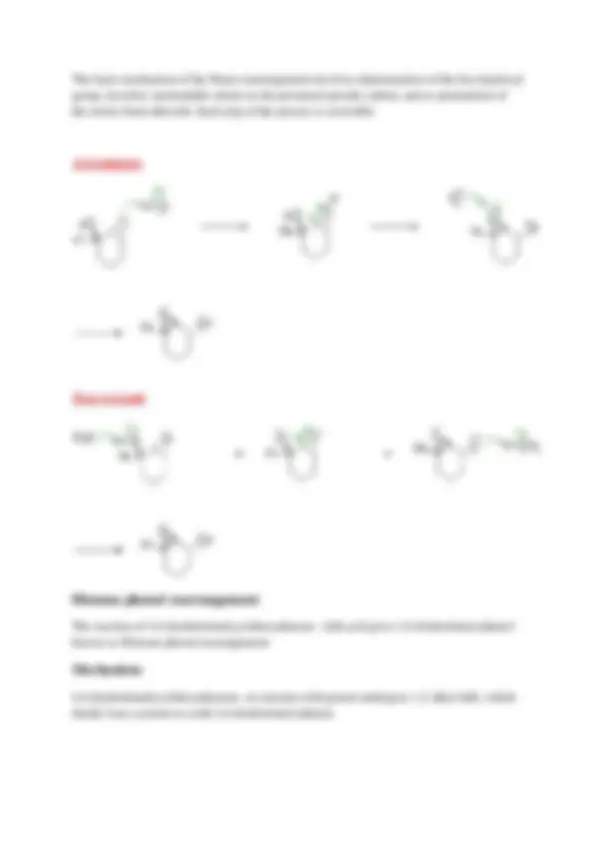



Study with the several resources on Docsity

Earn points by helping other students or get them with a premium plan


Prepare for your exams
Study with the several resources on Docsity

Earn points to download
Earn points by helping other students or get them with a premium plan
Community
Ask the community for help and clear up your study doubts
Discover the best universities in your country according to Docsity users
Free resources
Download our free guides on studying techniques, anxiety management strategies, and thesis advice from Docsity tutors
Mechanism of 1.pinacol-pinacolone 2.favorskii 3.deminov reaction............. By mohammad nadeem parray
Typology: Lecture notes
1 / 19

This page cannot be seen from the preview
Don't miss anything!












Course No: CH19202CR Title: Organic Chemistry (04 Credits)
Wagner-meerwein rearrangements are common in many reactions involving carbocation as intermediate. For example nucleophillic substitution occurs by an Sn^1 mechanism and may be accompanied by 1,2-methyle shift (rearrangement). Therefore such rearrangements which occur during reactions involving change in the carbon skeleton through rearrangement of carbocation as intermediate are collectively known as Wagner-meerwein rearrangements.
The first step in this rearrangement reaction is the generation of carbocation. Carbocation is formed in the reaction where loss of leaving group occurs, for example loss of water molecule from protonated alcohol. The carbocation can be also formed by the addition of electrophile to a double bond. The addition of proton to alkene takes place according to markonikffs rule. In the second step, the shift of a group, along with the pair of electrons, occur from one carbon atom to the adjacent cationic carbon atom. The resulting rearranged product either combines with a nucleophile or loses proton to alkene.
Acid catalysed dehydration of 1,2-diols usually lead to rearrangement with the formation of ketones. For example 2,3-dimethylbatane-2,3-diol (pinacol is treated with hot 30% sulphuric acid. 3,3-dimethyle-2-butanone (commonly known as pinacolone) is formed. This type of acid-catalysed dehydration reaction involving rearrangement of 1,2-diols is called pinacol- pinacolone rearrangement.
The mechanism of benzilic acid rearrangement is an example of 1,2-shift intra molecular rearrangement.
This arrangement involves three steps.
The benzilic acid rearrangement is an irreversible process. The first step of the mechanism is the addition of the nucleophile across the C=O bond to give a tetrahedral intermediate.
Doering extended the reaction to the formation of the corresponding ester by replacing the normal alkali by alkoxides. Thus benzil may directly be converted into alkyl benzilate by treatment with sodium alkoxide.
The Favorskii rearrangement, named for the Russian chemist Alexei Yevgrafovich Favorskii, is most principally a rearrangement of cyclopropanones and α-halo ketones which leads to carboxylic acid derivatives. In the case of cyclic α-halo ketones, the Favorskii rearrangement constitutes a ring contraction. This rearrangement takes place in the presence of a base, sometimes hydroxide, to yield a carboxylic acid but most of the time either an alkoxide base or an amine to yield an ester or an amide, respectively. α,α’-Dihaloketones eliminate HX under the reaction conditions to give α,β-unsaturated carbonyl compounds.
The reaction mechanism is thought to involve the formation of an enolate on the side of the ketone away from the chlorine atom. This enolate cyclizes to a cyclopropanoneintermediate which is then attacked by the hydroxide nucleophile.
Arndt-Eistert Synthesis
It is a base catalysed conversion of oxime tosylate to alpha-aminoketones via azirines. Tosyl esters of ketoxime having alpha-hydrogen atoms rearrange to give alpha-amino ketones under the catalytic influence of base, such as ethoxide ion or pyridine
There is enough evidence for the mechanism which involves the formation of an azirine. Cram and Hatch have confirmed the structure of isolated azirine. The base removes a proton, which undergoes internal displacement to form an intermediate azirine. Subsequent attack by water gives the final product, alpha-amino ketone.
The hofmann rearrangement is the organic reaction of a primary amide to a primary amine with one fewer carbon atom.
The reaction of bromine with sodium hydroxide forms sodium hypobromite in situ, which transforms the primary amide into an intermediate isocyanate.
The Curtius rearrangement is an organic reaction used to convert an acyl azide to an isocyanate under thermal conditions. The mechanism consists of an alkyl shift of the R group from the carbonyl carbon to the closest nitrogen with the release of nitrogen gas. The release of gas drives the reaction forward and results in the formation of the isocyanate product which can potentially react further in the presence of nucleophiles in solution
in Hoffmann rearrangement. Lossen rearrangement has little synthetic importance because hydroxamine acids are not readily available.
The conversion of carboxylic acid to primary amine having one carbon less is accomplished by Schmidt reaction. Schmidt reaction is mechanistically related to curtius reaction. However in this case conversion of carboxylic acid to primary amine occurs in one step by reaction with hydrazoic acid in the presence of conc. Sulphuric acid.
The addition of hydrazoic acid to a protonated carboxylic acid produces protonated acyle azide which loses nitrogen to give the intermediate. Subsequent removal of proton and rearrangement produces isocyanate, which is hydrolysed under the reaction conditions to
The rearrangement of oximes under the influence of a variety of acidic reagents to N- substituted amides is known as Beckmann rearrangement. Phosphorus pentachloride is
Treatment of oxime with acid generates a good leaving group (OH group is converted into H2O+ with H2SO4 ) on the nitrogen atom. The reaction mechanism is believed to consist of
A quaternary ammonium salt in which one of the alkyl group is having a beta-hydrogen atom but one of the alkyl group has an electron withdrawing group beta to the nitrogen atom, undergoes base catalysed rearrangement to yield a tertiary amine. The rearrangement involves migration of a group, without pair of electrons, from nitrogen to carbon having negative charge
A concerted reaction requires an antarafacial reaction mode but since the migrating group displays retention of configuration this mechanism is unlikely. In an alternative reaction mechanism the N–C bond of the leaving group is homolytically cleaved to form a di-radical pair (3a). In order to explain the observed retention of configuration, the presence of a solvent cage is invoked. Another possibility is the formation of a cation-anion pair (3b), also in a solvent cage. Recently the elimination recombination coupling mechanism opens a new approach to understand the formation of normal and abnormal product in the stevens rearrangement.
Dakin Reaction is the replacement of the aldehyde group of ortho and para hydroxy and ortho amino-benzaldehyde (or ketone) by a hydroxyl group on reaction with alkaline hydrogen peroxide. This reaction is closely related to Baeyer-Villiger oxidation. This reaction is named after a English chemist Henry Drysdale Dakin.
Nucleophilic addition reaction takes place to the carbonyl carbon.
Tetrahedral intermediate is formed, followed by elimination, generating phenyl ester.
Hydrolysis of phenyl ester forms the corresponding product.
In the first step of the reaction mechanism, the peroxyacid protonates the oxygen of the carbonyl group. This makes the carbonyl group more susceptible to attack by the peroxyacid. In the next step of the reaction mechanism, the peroxyacid attacks the carbon of the carbonyl group forming what is known as the Criegee intermediate. Through a concerted mechanism, one of the substituents on the ketone migrates to the oxygen of the peroxide group while a carboxylic acid leaves. This migration step is thought to be the rate determining step. Finally, deprotonation of the oxygen of the carbonyl group produces the ester.
The migratory ability is ranked tertiary ≻ secondary ≻ primary. Allylic groups also migrate better than primary groups but not as well as secondary groups. If there is an electron withdrawing group on the substituent, then it decreases the rate of migration. There are two explanations for this trend in migration ability. One explanation relies on the carbocation resonance structure of the Criegee intermediate. Keeping this structure in mind, it makes sense that the substituent that can maintain positive charge the best would be most likely to migrate. Tertiary groups are more stable carbocations than secondary groups, and secondary groups are more stable than primary. Therefore, the tertiary ≻ secondary ≻ primary trend is observed.
The Payne rearrangement is the isomerization, under basic conditions, of 2,3-epoxy alcohols to isomeric 2,3-epoxy alcohols with inversion of configuration. Aza- and thia-Payne rearrangements of aziridines and thiiraniums, respectively, are also known